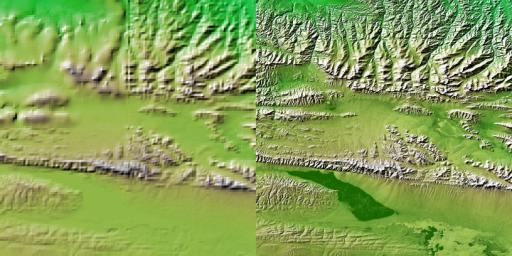These two images show exactly the same area, part of the Kunlun fault in northern Tibet. The image on the left was created using the best global topographic data set previously available, the U.S. Geological Survey's GTOPO30. In contrast, the much more detailed image on the right was generated with data from the Shuttle Radar Topography Mission, which collected enough measurements to map 80 percent of Earth's landmass at this level of precision.
The area covered is the western part of the Kunlun fault, at the north edge of east-central Tibet. The sharp line marking the southern edge of the mountains, running left to right across the scene represents s strike-slip fault, much like California's San Andreas Fault, which is more than 1,000 kilometers (621 miles) long. The most recent earthquake on the Kunlun fault occurred on November 14, 2001. At a magnitude of 8.1, it produced a surface break over 350 kilometers (217 miles) long. Preliminary reports indicate a maximum offset of 7 meters (23 feet) in the central section of the break. This five-kilometer (three mile) high area is uninhabited by humans, so there was little damage reported, despite the large magnitude. Shuttle Radar Topography Mission maps of active faults in Tibet and other parts of the world provide geologists with a unique tool for determining how active a fault is and the probability of future large earthquakes on the fault. This is done by both measuring offsets in topographic features and using the SRTM digital map as a baseline for processing data from orbiting satellites using the techniques of radar interferometry. Based on geologic evidence, the Kunlun fault's long-term slip rate is believed to be about 11 millimeters per year (0.4 inches per year). The Kunlun fault and the Altyn Tagh fault, 400 kilometers (249 miles) to the north, are two major faults that help accommodate the ongoing collision between the Indian and Asian tectonic plates.
In contrast with the wealth of detail visible in the Shuttle Radar Topography Mission topographic map (right), the best data previously available (left) barely discriminate the sharp break caused by the fault. Note also that the upper left quadrant of the GTOPO30 map was created from a lower-resolution source than the rest of the GTOPO30 data. Another major advantage of the shuttle radar mission is its consistent coverage, unlike previous topography data.
For some parts of the globe, the shuttle radar measurements are 30 times more precise than previously available topographic information, according to NASA scientists. Mission data will be a welcome resource for national and local governments, scientists, commercial enterprises and members of the public alike. The applications are as diverse as earthquake and volcano studies, flood control, transportation, urban and regional planning, aviation, recreation, and communications. The data's military applications include mission planning and rehearsal, modeling, and simulation.
This image combines three visualizations of data from the Shuttle Radar Topography Mission. The image brightness corresponds to the strength of the radar signal reflected from the ground combined with shaded relief derived from the mission's topography measurements, while colors show the mission's elevation measurements. Colors range from blue at the lowest elevations to brown and white at the highest elevations.
Elevation data used in this image were acquired by the Shuttle Radar Topography Mission aboard Space Shuttle Endeavour, launched on Feb. 11, 2000. The Shuttle Radar Topography Mission used the same radar instrument that comprised the Spaceborne Imaging Radar-C/X-Band Synthetic Aperture Radar (SIR-C/X-SAR) that flew twice on Endeavour in 1994. The Shuttle Radar Topography Mission was designed to collect 3-D measurements of Earth's surface. To collect the 3-D data, engineers added a 60-meter (approximately 200-foot) mast, installed additional C-band and X-band antennas, and improved tracking and navigation devices. The mission is a cooperative project between NASA, the National Imagery and Mapping Agency (NIMA) of the U.S. Department of Defense and the German and Italian space agencies. It is managed by NASA's Jet Propulsion Laboratory, Pasadena, Calif., for NASA's Earth Science Enterprise, Washington, D.C.
Size: 111 by 90 kilometers (69 by 56 miles)
Location: 36.0 degrees north latitude, 93.0 degrees east longitude
Orientation: North is at the top
Date Acquired: February 2000 (SRTM)

 Planetary Data System
Planetary Data System












